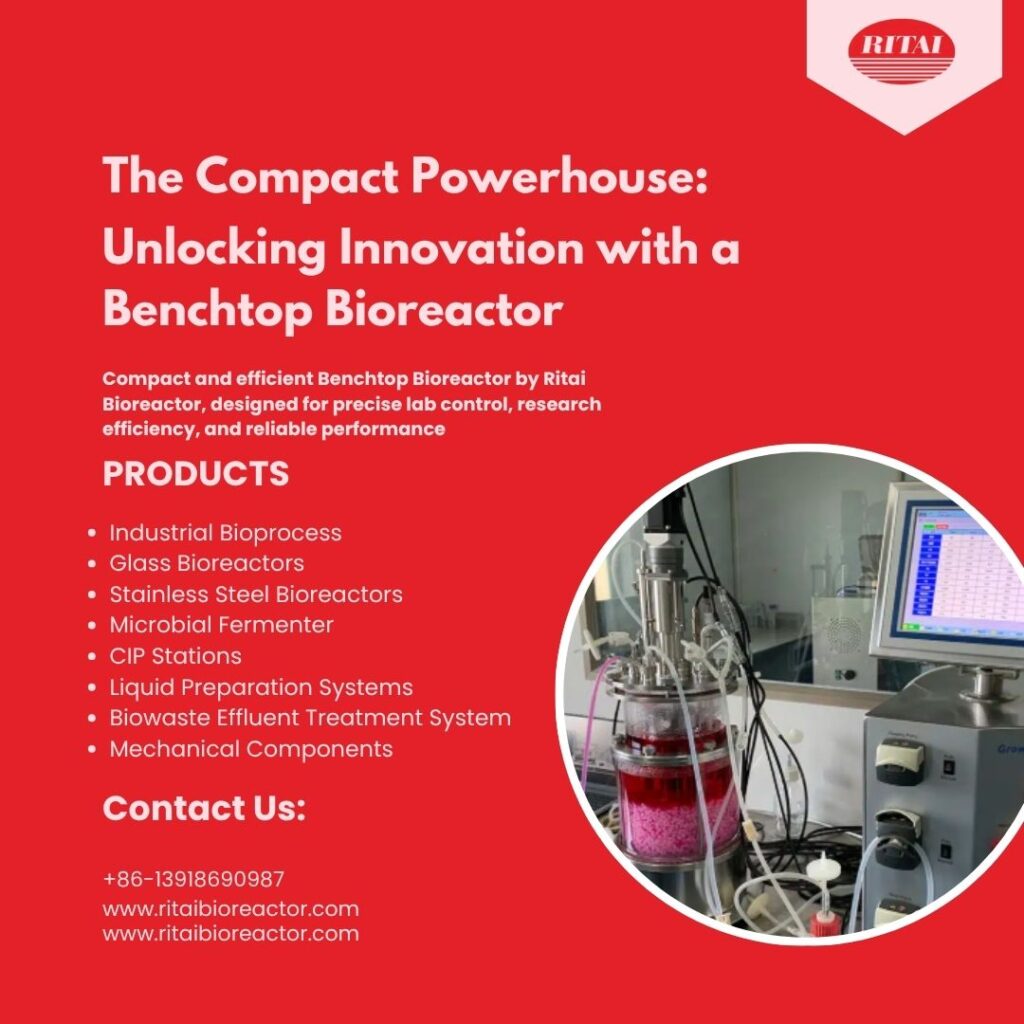
Biotechnological innovation begins with simple research on a thoroughly equipped laboratory countertop and not in a huge production hall. Benchtop bioreactors for sale are an important part in developing understanding and enabling the control of microorganisms productivity for further advancements in biotechnology. These systems are not only used for research on understanding microorganisms and developing control systems for productivity, but also serve to outline and help in the complex decision-making processes in technology and production advancements. Understanding the different bioreactors and choosing the right systems and configured systems to aid the decision-making processes in technology and production advancements is multidimensional. Simple stirred-tank to more complex airlift designs determines the technology and process advancements in many biotechnological innovation fields. This is the primary focus and main theme in writing this. Advanced decision making with biotechnological innovation encompasses a wide variety of biotechnological fields. This is what provides the motivation to further research and focus… and bioreactor… and biotechnological innovation. Biotechnological innovation.
More Than a Miniature: Defining the Benchtop Bioreactor
A benchtop bioreactor is precisely what its name suggests: a compact fermentation system designed to sit conveniently on a laboratory bench. However, to view it as merely a small version of its industrial-sized cousin is to miss its true significance. These units are fully functional bioprocessing systems, typically ranging from 1 to 10 liters in volume that incorporate all the essential features for sophisticated microbial cultivation and cell culture. They provide precise control over critical parameters such as temperature, pH, dissolved oxygen, and agitation. This level of control is paramount for process optimization, allowing researchers to replicate conditions on a small scale before committing to costly large-scale production. The benchtop bioreactor serves as a vital platform for media development, strain selection, and initial process characterization, making it an indispensable asset in any bioprocessing laboratory focused on upstream processing.
A Landscape of Design: Exploring Fundamental Bioreactor Types
There are many different bioreactor types and configurations within the field of bioprocess engineering, each with its own specialized benefits resulting from several biological and processing needs. The workhorse for most benchtop and industrial applications is the Stirred-Tank Reactor (STR). The design is simple yet effective: an impeller or agitator is used for mixing the culture and achieving homogeneity, while a sparger system is used to provide oxygen for aerobic bioprocesses. The simplicity of the design and well-defined mixing dynamics are the main reasons it is a bioprocessing default. Wave Bioreactors are innovative systems designed especially for sensitive cell culture cases. The impeller is replaced by a rocking mechanism and waves are created within a disposable bag, tracer, and oxygen is infused, achieving gentle mixing, oxygen transfer, and shear stress. The Airlift Bioreactor completely eliminates the need for a mechanical agitator. It uses injected gas to oxygenate the culture and sustain circulation through the draft tube. The choice between different bioreactor types will depend on the sensitivity of the organism to shear forces, the system simplicity, and the oxygen demand.
The Engine of Discovery: Key Applications in Research and Development
Benchtop bioreactors are valuable tools for discovery and development in the life sciences. In pharmaceutical development, these systems help produce small-scale therapeutic proteins, monoclonal antibodies, and vaccines for pre-clinical trials. They hold importance in process scale-up studies, where information from the benchtop unit is used in designing and operating larger pilot-scale fermenters. In the rapidly growing field of synthetic biology, researchers employ benchtop bioreactors to evaluate the performance of genetically modified microbial strains. Certain feeding strategies, moving from simple batch fermentation to more regulated fed-batch processes, greatly increase the concentration of the target product, such as an industrial enzyme or biobased chemical. Defining knowledge is built in this R&D stage, determining the success or failure of a project long before the manufacturing stage.
Precision and Control: The Technological Heart of the System
What really distinguishes a modern benchtop bioreactor from a simple flask of growing cells is its integrated system of precision controls and sensors. This is the technological heart that enables reproducible and meaningful research. Key to this is pH control, maintained by automated pumps that add acid or base to keep cells or microorganisms in the optimum environment. Equally critical is dissolved oxygen (DO) control, which is frequently managed by cascading control loops that automatically adjust the agitation speed and the gas flow rate to the culture and the oxygen that is in the inlet gas to satisfy the fluctuating metabolic demands of the culture. The advanced sensors that measure these and other parameters in real time under the Control of Process Analytical Technology (PAT) System of Control Bioprocesses. The System of Control PAT. This system of control is foundational to robust bioprocess modeling and ensures that every experiment in a benchtop bioreactor reinforces the development pipeline with rich, high-quality data.
Choosing the Right Tool: How Bioreactor Types Shape Research Outcomes
Choosing the right bioreactor types is crucial for the success of the bioprocess. For instance, the Stirred-Tank Reactor is a good all-round option for bacterial fermentation if a high oxygen transfer rate is required and shear stress is not a major issue. However, in the case of mammalian cell cultures, where the cells are fragile, or with shear-sensitive filamentous fungi, the aggressive mixing with a standard impeller may cause cell damage or loss of viability. In such situations, a bioreactor with a low-shear impeller, such as a pitched-blade or marine propeller, a Wave Bioreactor, or a combination of the above, is a better option. Also, in situations where there is a high emphasis on less mechanical complexity and reducing the risk of contamination with sealed and bearing-mounted supports, the Airlift Bioreactor is a very good option. The mechanical properties of the culture broth and viscosity are also very important in making the final decision.
Bridging the Scale-Up Gap: From Benchtop to Production
One of the most important benchtop bioreactor functions is performing the scale-up. The data and the operation plans developed at the benchtop level serve as the foundation for larger operations. However, scaling a biological process is more than just adding volume; it is intricately adjusting and changing the physical parameters. Mixing time and mass transfer phenomena—the efficiency of oxygen transfer from a gas bubble to the cell—behaves differently as the vessel size increases. A benchtop bioreactor provides the engineers an opportunity to understand these phenomena and develop scale-down models. By solving potential nutrient gradients and foam control problems within the benchtop environment, researchers can help to pilot-scale fermenters and beyond to the scale-up process in bioprocess development effectively and efficiently. This solving of the scale-up gaps is a cornerstone of bioprocess development.
Emerging Trends in Benchtop Technology
The primary focus of future benchtop bioreactors will be intensification, automation, and integration. Recent advances in high-throughput bio processing technologies are making it possible to work with micro bioreactors in arrays with even smaller volumes, which can be used to parallel screen dozens of conditions in seconds. These systems can considerably speed media optimization and clone selection. Additionally, sensor technology is providing more detailed insights into the cultures’ metabolic activities and increasingly measuring in real-time the more complex and non-standard cell viability, metabolites, and other activities beyond the basic parameters. This is in line with the increasing use of continuous fermentation at the bench scale, which offers improved productivity over traditional batch systems. Increasingly sophisticated data analytical approaches and automation in the systems will allow the benchtop bioreactor to finally shed its image as a manual experimentation tool and become an intelligent integrated unit in the digitalized bio manufacturing workflow.
Conclusion: The Indispensable Foundation of Bio processing
To conclude, the benchtop bioreactor is much more than a certain type of laboratory equipment; it is an indispensable building block for the entire modern bio processing infrastructure. The bioreactor’s tunable, scalable systems for cell and microorganism culture construction make it the basis for nearly all of the field’s significant bio processing advancements. By serving as the platform for the tremendous class of bioreactors and associated applications, the bench top bioreactor enables and empowers bio processing scientists to make choices all the way to the commercial production of a biopharmaceutical. The bench top bioreactor is and will always be the compact engine of modern bio processing where all big ideas first learn to grow.

